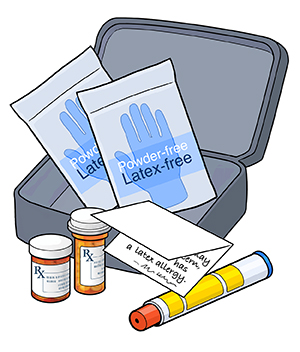A
B
C
D
E
F
G
H
I
J
K
L
M
N
O
P
Q
R
S
T
U
V
W
X
Y
Z
Topic IndexLibrary Index
Click a letter to see a list of conditions beginning with that letter.
Click 'Topic Index' to return to the index for the current topic.
Click 'Library Index' to return to the listing of all topics.
Living with Latex Allergies
Once you are diagnosed with a latex allergy, you can take some steps to protect yourself. Follow your healthcare provider’s instructions and the guidelines below.
Carry an allergy kit
The kit should include:
-
Injectable epinephrine. This can stop an allergic reaction (your healthcare provider will give you a prescription for it).
-
Non-latex surgical gloves. You can wear these or give them to others to wear if they must care for you.
-
A note from your provider stating that you have a latex allergy
-
A complete list of the medicines you take
 |
| An allergy kit can help keep you safe in an emergency. Carry it with you at all times. |
Alert others to your latex allergy
-
Always wear a medical alert bracelet that tells others that you have a latex allergy. This lets them know that they should not use latex when they care for you. You may also want to put a sign in your car window and near your front door that says you have a latex allergy.
-
In addition, contact your healthcare providers (including your dentist and local hospital). Have them note on your chart or file that you are allergic to latex.
-
You may want to call ahead to restaurants to be sure that the food handlers are using latex-free gloves. People who are allergic to latex are also often allergic to certain fruits. These include banana, avocado, papaya, chestnuts, tomato, or kiwi. You may need to not eat these foods, as well.
Educate your loved ones
It may be hard for your friends and family to understand your latex allergy. Let them know when and how to use your medicines and when to call for emergency help. If they understand your allergy, they will be better able to help you prevent or stop an allergic reaction.
Know the signs of anaphylactic shock
Anaphylactic shock is a life-threatening allergic reaction. If you have signs of shock, use your epinephrine immediately. Then call 911 and get emergency medical care right away. Even if you feel better, get emergency care.
The signs of anaphylactic shock include the following:
Online Medical Reviewer:
Marianne Fraser MSN RN
Online Medical Reviewer:
Raymond Kent Turley BSN MSN RN
Online Medical Reviewer:
Robert Hurd MD
Date Last Reviewed:
11/1/2022
© 2000-2025 The StayWell Company, LLC. All rights reserved. This information is not intended as a substitute for professional medical care. Always follow your healthcare professional's instructions.